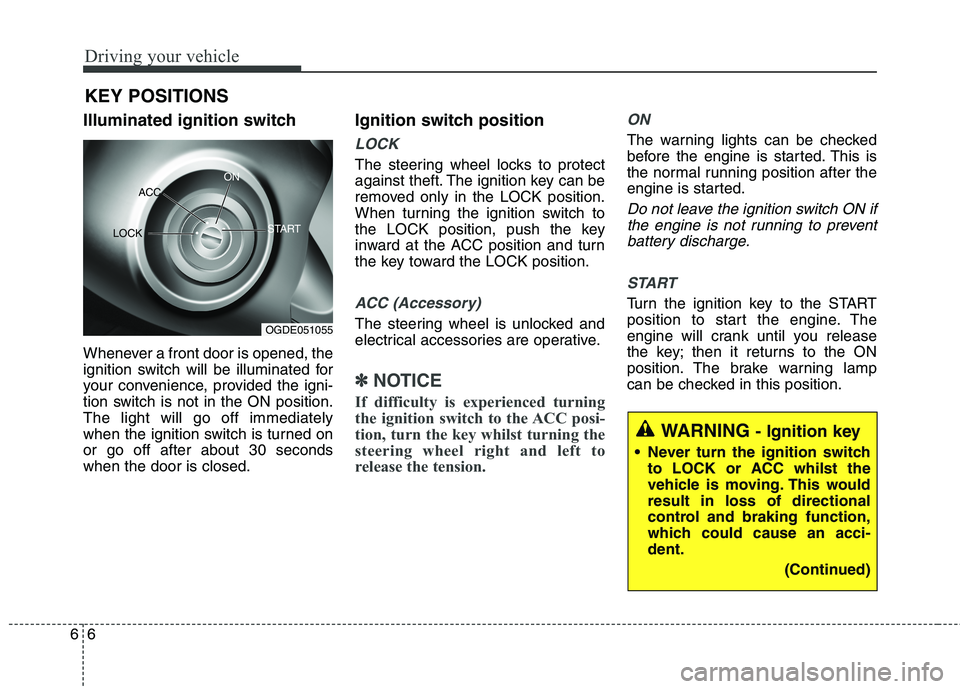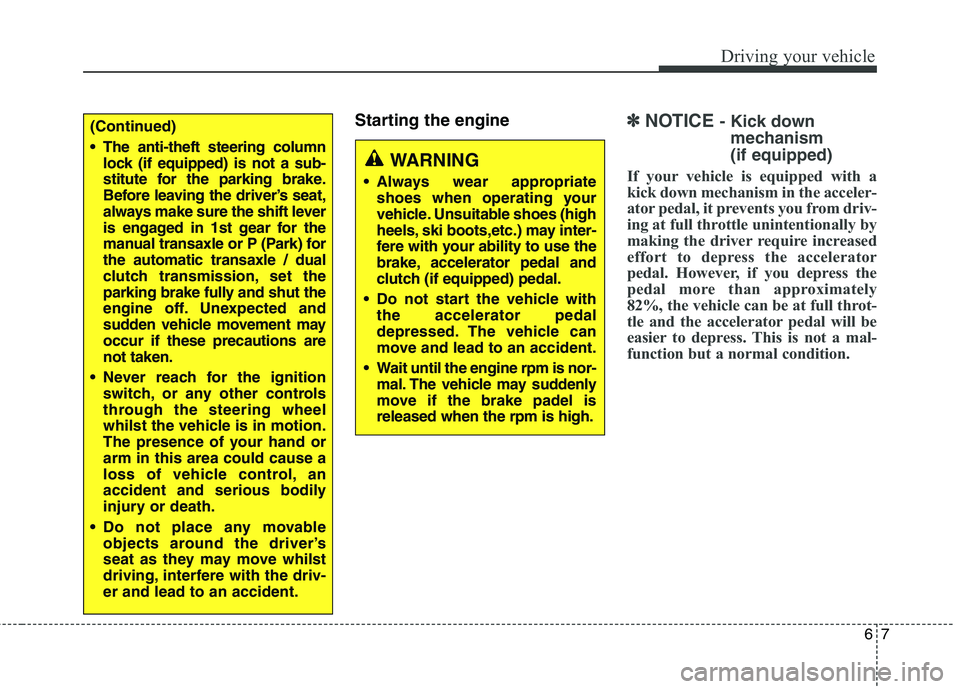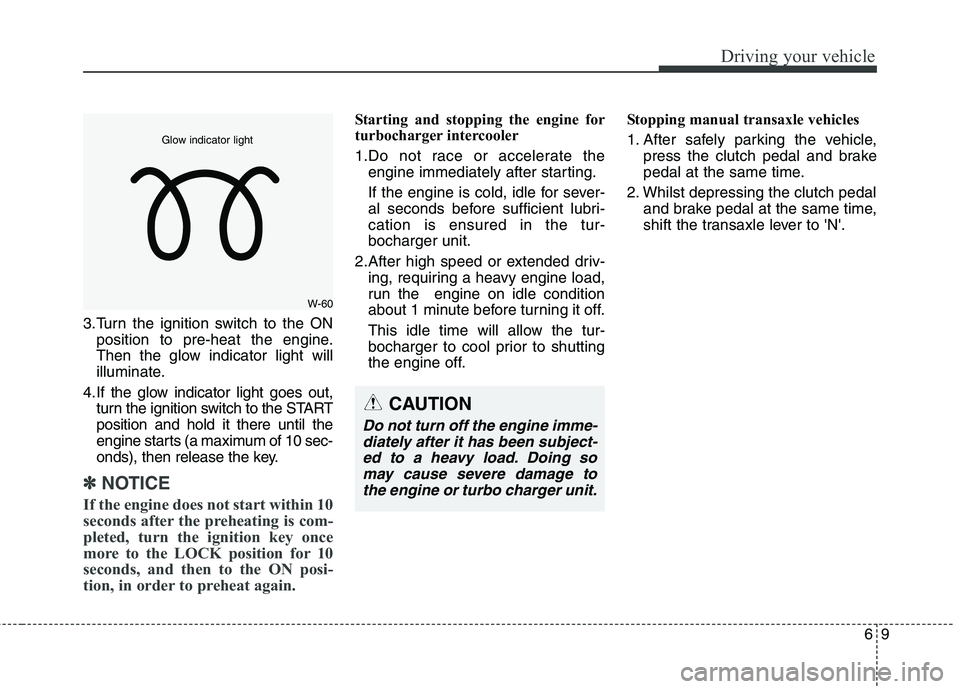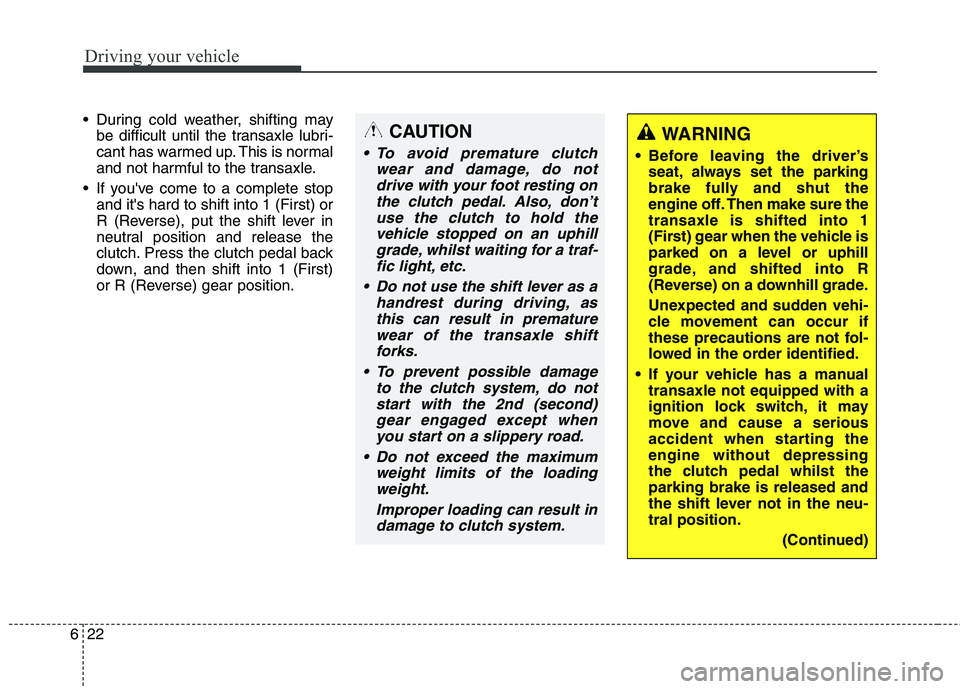2017 KIA CARENS RHD ignition
[x] Cancel search: ignitionPage 441 of 723

Driving your vehicle
6
6
Illuminated ignition switch
Whenever a front door is opened, the
ignition switch will be illuminated for
your convenience, provided the igni-
tion switch is not in the ON position.The light will go off immediately
when the ignition switch is turned onor go off after about 30 secondswhen the door is closed. Ignition switch position
LOCK
The steering wheel locks to protect
against theft. The ignition key can be
removed only in the LOCK position.
When turning the ignition switch to
the LOCK position, push the key
inward at the ACC position and turn
the key toward the LOCK position.
ACC (Accessory)
The steering wheel is unlocked and
electrical accessories are operative.
✽✽
NOTICE
If difficulty is experienced turning
the ignition switch to the ACC posi-
tion, turn the key whilst turning the
steering wheel right and left to
release the tension.
ON
The warning lights can be checked
before the engine is started. This is
the normal running position after the
engine is started.
Do not leave the ignition switch ON if the engine is not running to preventbattery discharge.
START
Turn the ignition key to the START
position to start the engine. The
engine will crank until you release
the key; then it returns to the ON
position. The brake warning lamp
can be checked in this position.
KEY POSITIONS
WARNING
- Ignition key
Never turn the ignition switch to LOCK or ACC whilst the
vehicle is moving. This wouldresult in loss of directional
control and braking function,
which could cause an acci-dent.
(Continued)
OGDE051055
ACC
ON
START
LOCK
Page 442 of 723

67
Driving your vehicle
Starting the engine✽✽NOTICE - Kick down
mechanism (if equipped)
If your vehicle is equipped with a
kick down mechanism in the acceler-
ator pedal, it prevents you from driv-
ing at full throttle unintentionally by
making the driver require increased
effort to depress the accelerator
pedal. However, if you depress the
pedal more than approximately
82%, the vehicle can be at full throt-
tle and the accelerator pedal will be
easier to depress. This is not a mal-
function but a normal condition.(Continued)
The anti-theft steering column lock (if equipped) is not a sub-
stitute for the parking brake.
Before leaving the driver’s seat,
always make sure the shift lever
is engaged in 1st gear for the
manual transaxle or P (Park) forthe automatic transaxle / dual
clutch transmission, set the
parking brake fully and shut the
engine off. Unexpected and
sudden vehicle movement mayoccur if these precautions arenot taken.
Never reach for the ignition switch, or any other controls
through the steering wheel
whilst the vehicle is in motion.
The presence of your hand orarm in this area could cause a
loss of vehicle control, an
accident and serious bodily
injury or death.
Do not place any movable objects around the driver’s
seat as they may move whilst
driving, interfere with the driv-er and lead to an accident.
WARNING
Always wear appropriate shoes when operating your
vehicle. Unsuitable shoes (high
heels, ski boots,etc.) may inter-
fere with your ability to use the
brake, accelerator pedal and
clutch (if equipped) pedal.
Do not start the vehicle with the accelerator pedal
depressed. The vehicle can
move and lead to an accident.
Wait until the engine rpm is nor- mal. The vehicle may suddenly
move if the brake padel isreleased when the rpm is high.
Page 443 of 723

Driving your vehicle
8
6
Starting the petrol engine
1.Make sure the parking brake is
applied.
2. Manual Transaxle - Depress the
clutch pedal fully and shift the
transaxle into Neutral. Keep the
clutch pedal and brake pedal
depressed whilst turning the igni-
tion switch to the start position.
Automatic Transaxle - Place the
transaxle shift lever in P (Park).
Depress the brake pedal fully.
You can also start the engine when
the shift lever is in the N (Neutral)position.
3.Turn the ignition switch to START and hold it there until the engine
starts (a maximum of 10 seconds),
then release the key.
It should be started without
depressing the accelerator pedal.
4.Do not wait for the engine to warm up whilst the vehicle remains sta-
tionary.
Start driving at moderate engine
speeds. (Steep accelerating and
decelerating should be avoided.)
Starting the diesel engine
To start the diesel engine when the engine is cold, it has to be pre-heat-
ed before starting the engine and
then have to be warmed up before
starting to drive.
1.Make sure the parking brake isapplied.
2. Manual Transaxle - Depress the
clutch pedal fully and shift the
transaxle into Neutral. Keep the
clutch pedal and brake pedal
depressed whilst turning the igni-
tion switch to the start position.
Dual clutch transmission - Place
the transaxle shift lever in P(park).
Depress the brake pedal fully.
You can also start the engine when
the shift lever is in the N(neutral)position.
CAUTION
If the engine stalls whilst youare in motion, do not attempt tomove the shift lever to the P (Park) position. If traffic androad conditions permit, you mayput the shift lever in the N(Neutral) position whilst the vehicle is still moving and turnthe ignition switch to the STARTposition in an attempt to restart the engine.
CAUTION
Do not engage the starter for more than 10 seconds. If theengine stalls or fails to start,wait 5 to 10 seconds before re-engaging the starter. Improper use of the starter may damageit.
Do not turn the ignition switch to the START position with theengine running. It may dam- age the starter.
Page 444 of 723

69
Driving your vehicle
3.Turn the ignition switch to the ONposition to pre-heat the engine.
Then the glow indicator light will
illuminate.
4.If the glow indicator light goes out, turn the ignition switch to the STARTposition and hold it there until the
engine starts (a maximum of 10 sec-
onds), then release the key.
✽✽ NOTICE
If the engine does not start within 10
seconds after the preheating is com-
pleted, turn the ignition key once
more to the LOCK position for 10
seconds, and then to the ON posi-
tion, in order to preheat again.
Starting and stopping the engine for
turbocharger intercooler
1.Do not race or accelerate the engine immediately after starting.
If the engine is cold, idle for sever-
al seconds before sufficient lubri-cation is ensured in the tur-bocharger unit.
2.After high speed or extended driv- ing, requiring a heavy engine load,
run the engine on idle condition
about 1 minute before turning it off.
This idle time will allow the tur-
bocharger to cool prior to shutting
the engine off. Stopping manual transaxle vehicles
1. After safely parking the vehicle,
press the clutch pedal and brake
pedal at the same time.
2. Whilst depressing the clutch pedal and brake pedal at the same time,
shift the transaxle lever to 'N'.
W-60
Glow indicator light
CAUTION
Do not turn off the engine imme-
diately after it has been subject- ed to a heavy load. Doing somay cause severe damage tothe engine or turbo charger unit.
Page 455 of 723

Driving your vehicle
20
6
ISG system malfunction
The system may not operate
when:
The ISG related sensors or system
error occurs.
The following will happen:
The yellow AUTO STOP ( ) indi- cator on the instrument cluster will
stay on after blinking for 5 seconds.
The light on the ISG OFF button will illuminate.
✽✽ NOTICE
If the ISG OFF button light is not turned off by pressing the ISG
OFF button again or if the ISG
system continuously does not
work correctly, we recommend
that you contact an authorised Kia
dealer as soon as possible.
When the ISG OFF button light comes on, it may stop illuminating
after driving your vehicle at
approximately 80 km/h for a max-
imum of two hours and setting the
fan speed control knob below the
2nd position. If the ISG OFF but-
ton light continues to be illuminat-
ed in spite of the procedure, we
recommend that you contact an
authorised Kia dealer as soon as
possible.
ORP056008R
WARNING
When the engine is in Idle Stop
mode, it's possible to restart theengine without the driver taking
any action.
Before leaving the car or doing
anything in the engine room
area, stop the engine by turning
the ignition switch to the
LOCK/OFF position or remov-
ing the ignition key.
Page 456 of 723

621
Driving your vehicle
Manual transaxle operation
The manual transaxle has 6 for-ward gears.
This shift pattern is imprinted on
the shift knob. The transaxle is fully
synchronized in all forward gearsso shifting to either a higher or a
lower gear is easily accomplished. Depress the clutch pedal down
fully whilst shifting, then release it
slowly.
If your vehicle is equipped with an
ignition lock switch, the engine will
not start when starting the enginewithout depressing the clutchpedal.
In order to start the vehicle, slowly let go of the fully depressed clutch
pedal. Then, push the accelerator
pedal to start.
The shift lever must return to the neutral position before shifting into
R (Reverse). The button located
immediately below the shift knob
must be pushed upward whilst
moving the shift lever to the R
(Reverse) position.
Make sure the vehicle is complete-
ly stopped before shifting into R(Reverse).
Never operate the engine with thetachometer (rpm) in the red zone.
MANUAL TRANSAXLE (IF EQUIPPED)
OJD052004
The button (1) must be pushed whilst
moving the shift lever.
The shift lever can be moved without
pushing the button (1).
CAUTION
When downshifting from 5
(Fifth) gear to 4 (Fourth) gear,caution should be taken not to inadvertently move the shiftlever sideways in such a man-ner that second gear is engaged. Such a drasticdownshift may cause theengine speed to increase to the point that the tachometerwill enter the red-zone. Suchover-revving of the engine may possibly cause engineand transaxle damage.
Do not downshift more than 2 gears or downshift the gearwhen the engine is running at high speed (5,000 RPM orhigher). Such a downshiftingmay damage the engine, clutch and the transaxle.
When shifting between 5th and 6th gear, you shouldalways push the gear level allthe way to the right. You could otherwise shift unintentionallyinto 3rd or 4th gear and dam-age the transaxle.
Page 457 of 723

Driving your vehicle
22
6
During cold weather, shifting may
be difficult until the transaxle lubri-
cant has warmed up. This is normal
and not harmful to the transaxle.
If you've come to a complete stop and it's hard to shift into 1 (First) or
R (Reverse), put the shift lever in
neutral position and release the
clutch. Press the clutch pedal back
down, and then shift into 1 (First)
or R (Reverse) gear position.CAUTION
To avoid premature clutch
wear and damage, do notdrive with your foot resting on the clutch pedal. Also, don’tuse the clutch to hold thevehicle stopped on an uphill grade, whilst waiting for a traf-fic light, etc.
Do not use the shift lever as a handrest during driving, asthis can result in premature wear of the transaxle shiftforks.
To prevent possible damage to the clutch system, do notstart with the 2nd (second) gear engaged except whenyou start on a slippery road.
Do not exceed the maximum weight limits of the loadingweight.
Improper loading can result indamage to clutch system.
WARNING
Before leaving the driver’s seat, always set the parking
brake fully and shut the
engine off. Then make sure thetransaxle is shifted into 1
(First) gear when the vehicle is
parked on a level or uphill
grade, and shifted into R
(Reverse) on a downhill grade.
Unexpected and sudden vehi-
cle movement can occur if
these precautions are not fol-
lowed in the order identified.
If your vehicle has a manual transaxle not equipped with a
ignition lock switch, it may
move and cause a serious
accident when starting theengine without depressing
the clutch pedal whilst theparking brake is released and
the shift lever not in the neu-tral position.
(Continued)
Page 462 of 723

627
Driving your vehicle
For smooth operation, depress thebrake pedal when shifting from N(Neutral) to a forward or reverse gear.Transaxle ranges
The indicator lights in the instrument
cluster displays the shift lever posi-
tion when the ignition switch is in theON position.
P (Park)
Always come to a complete stop
before shifting into P (Park). This
position locks the transaxle and pre-
vents the front wheels from rotating.
WARNING - Automatic
transaxle
Always check the surrounding areas near your vehicle for
people, especially children,
before shifting a vehicle into
D (Drive) or R (Reverse).
Before leaving the driver’s seat, always make sure the
shift lever is in the P (Park)
position; then set the parking
brake fully and shut the engine
off. Unexpected and sudden
vehicle movement can occur if
these precautions are not fol-
lowed in the order identified.
Do not use the engine brake (shifting from a high gear to
lower gear) rapidly on slip-
pery roads.
The vehicle may slip causing an accident.
CAUTION
To avoid damage to your
transaxle, do not acceleratethe engine in R (Reverse) orany forward gear position withthe brakes on.
When stopped on an upgrade, do not hold the vehicle sta-tionary with engine power.Use the service brake or theparking brake.
Do not shift from N (Neutral) or P (Park) into D (Drive), or R(Reverse) when the engine isabove idle speed.
WARNING
Shifting into P (Park) whilst the vehicle is in motion will
cause the drive wheels to lock
which will cause you to lose
control of the vehicle.
Do not use the P (Park) posi- tion in place of the parking
brake. Always make sure the
shift lever is latched in the P
(Park) position and set the
parking brake fully.
Never leave a child unattend- ed in a vehicle.